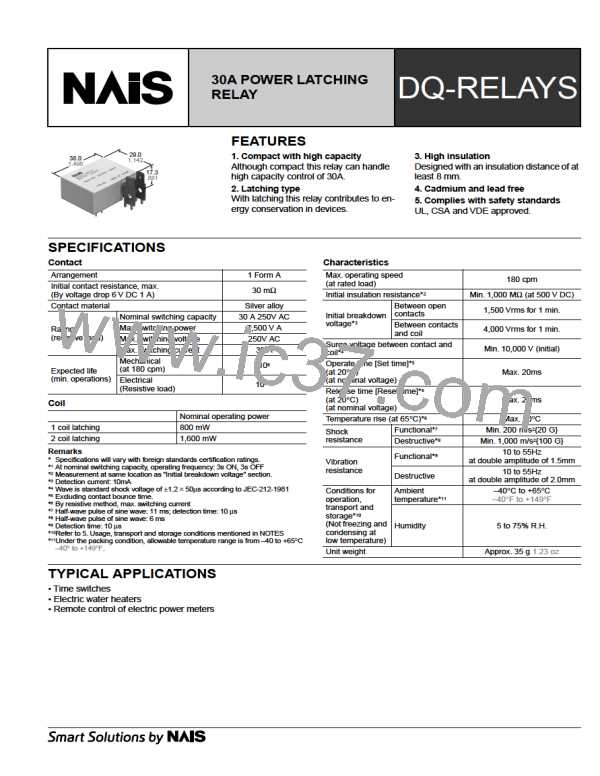DQ
NOTES
1. Coil operating power
6) Check the ambient conditions when
storing or transporting the relays and de-
vices containing the relays. Freezing or
condensation may occur in the relay,
causing functional damage. Avoid sub-
jecting the relays to heavy loads, or strong
vibration and shocks.
Pure DC current should be applied to the
coil.The wave form should be rectangular.
If it includes ripple, the ripple factor should
be less than 5%. However, check it with
the actual circuit since the characteristics
may be slightly different.
2. Coil connection
5. Usage, transport and storage condi-
tions
1) Ambient temperature, humidity, and at-
mospheric pressure during usage, trans-
port, and storage of the relay:
(1) Temperature:
–40 to +65°C – 40 to +149° F
(2) Humidity: 5 to 75% RH
(Avoid freezing and condensation.)
The humidity range varies with the tempera-
ture. Use within the range indicated in the
graph below.
When connecting coils, refer to the wiring
diagram to prevent mis-operation or mal-
function.
3. Soldering
We recommend the following soldering
conditions
Soldering: 300°C 572° F, max. 5 s
4. Others
1) If the relay has been dropped, the ap-
pearance and characteristics should al-
ways be checked before use.
Humidity, %RH
2) The cycle lifetime is defined under the
standard test condition specified in the
JIS* C 5442-1996 standard (temperature
15 to 35°C 59 to 95°F, humidity 25 to
75%). Check this with the real device as it
is affected by coil driving circuit, load type,
activation frequency, activation
75
Tolerance range
(Avoid
(Avoid freezing
condensation
when used at
when used at
temperatures lower
temperatures higher
than 0°C 32°F)
than 0°C 32°F)
5
phase,ambient conditions and other fac-
tors.
–40
–40
0
65
+119
+32
Temperature, °C °F
Also, be especially careful of loads such
as those listed below.
(1) When used for AC load-operating and
the operating phase is synchronous.
Rocking and fusing can easily occur due
to contact shifting.
(2) High-frequency load-operating
When high-frequency opening and clos-
ing of the relay is performed with a load
that causes arcs at the contacts, nitrogen
and oxygen in the air is fused by the arc
energy and HNO3 is formed.This can cor-
rode metal materials.
(3) Atmospheric pressure: 86 to 106 kPa Tem-
perature and humidity range for usage, trans-
port, and storage:
2) Condensation
Condensation forms when there is a sud-
den change in temperature under high
temperature and high humidity conditions.
Condensation will cause deterioration of
the relay insulation.
3) Freezing
Condensation or other moisture may
freeze on the relay when the tempera-
tures is lower than 0°C 32° F.This causes
problems such as sticking of movable
parts or operational time lags.
4) Low temperature, low humidity environ-
ments
The plastic becomes brittle if the relay is
exposed to a low temperature, low humid-
ity environment for long periods of time.
Three countermeasures for these are listed
here.
1. Incorporate an arc-extinguishing cir-
cuit.
2. Lower the operating frequency
3. Lower the ambient humidity
3) For secure operations, the voltage ap-
plied to the coil should be nominal volt-
age. In addition, please note that pick-up
and drop-out voltage will vary according
to the ambient temperature and operation
conditions.
4) Heat, smoke, and even a fire may occur
if the relay is used in conditions outside of
the allowable ranges for the coil ratings,
contact ratings, operating cycle lifetime,
and other specifications. Therefore, do
not use the relay if these ratings are ex-
ceeded. Also, make sure that the relay is
wired correctly.
5) Incorrect wiring may cause unexpected
events or the generation of heat or flames.
12/1/2001
All Rights Reserved, © Copyright Matsushita Electric Works, Ltd.
3
Go To Online Catalog

 NAIS [ NAIS(MATSUSHITA ELECTRIC WORKS) ]
NAIS [ NAIS(MATSUSHITA ELECTRIC WORKS) ]